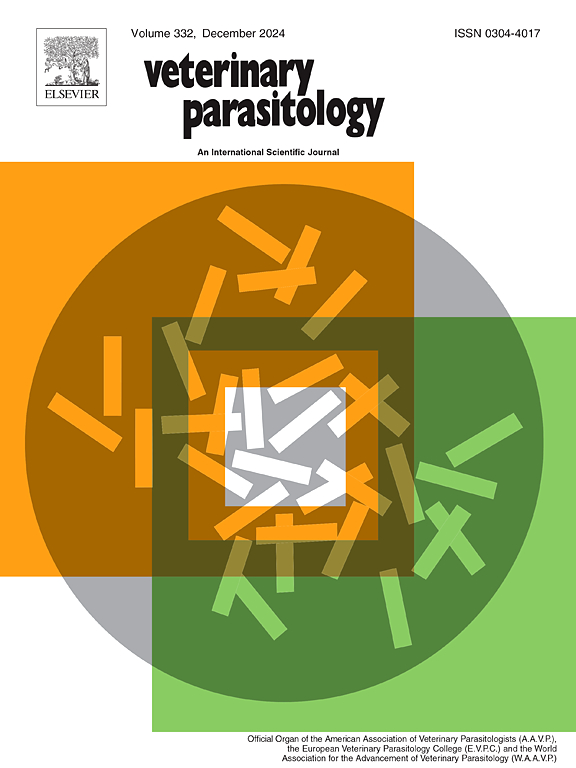Worm replacement with susceptible Haemonchus contortus benefits weight gain, reduces anthelmintic treatments and impacts sheep breeds differently
IF 2
2区 农林科学
Q2 PARASITOLOGY
引用次数: 0
Abstract
This study evaluated the effect of partial and total replacement of Haemonchus contortus in sheep breeds. Pregnant ewes of White Dorper (DO), Santa Inês (SI) and Texel (TX) breeds were allocated into three groups: Control (C), Partial Replacement (PR) and Total Replacement (TR). PR and TR ewes received anthelmintics (AH), were artificially infected with H. contortus-susceptible isolate and grazed on resistant-infested or worm-free paddocks, respectively. Control animals were untreated and naturally infected. 106 lambs were born and kept in the paddocks of their respective mothers. Their egg count per gram of feces (FEC) and packed cell volume (PCV) were recorded every 21 days, until 189 days old. Fecal Egg Count Reduction Test revealed AH efficacy of 85 %, 92 % and 97 % in the C, PR and TR groups, respectively, for ewes and 60 %, 74 % and 98 %, respectively, for lambs at day 147. SI animals (p < 0.001) received fewer AH treatments and presented a higher PCV than DO and TX, reaching similar weight gain to the other breeds. Male lambs (p < 0.001) presented a higher FEC, lower PCV and lower frequency of Famacha score 1. Higher age at weaning resulted in a lower FEC (p = 0.0073), higher PCV (p = 0.002), and higher frequencies of Famacha 1 and body condition scores 3 and 4. AH treatment was more efficient after worm replacement, reducing FEC (p < 0.001) and favoring weight gain in the PR and TR groups. Avoiding early weaning, adopting selective AH treatments and using more resistant sheep breeds may delay the reestablishment of resistance after worm replacement.
用易受感染的弯曲血蜱代替蠕虫有利于增加体重,减少驱虫治疗,并对绵羊品种产生不同的影响
本研究评价了部分替代和全部替代弯曲血螨在绵羊品种中的效果。选用白杜珀(DO)、桑塔Inês (SI)和特塞尔(TX)妊娠母羊,分为对照(C)、部分替代(PR)和完全替代(TR) 3组。PR母羊和TR母羊分别接受抗虫药(AH),人工感染弓形螺旋虫敏感分离物,并在有抗性或无虫的围场放牧。对照动物未经治疗,自然感染。106只羊羔出生后被饲养在各自母亲的围场里。每21 d记录每克粪便卵数(FEC)和堆积细胞体积(PCV),直至189日龄。粪蛋计数减少试验显示,第147天,C、PR和TR组对母羊的AH效率分别为85 %、92 %和97 %,对羔羊的AH效率分别为60 %、74 %和98 %。SI动物(p <; 0.001)接受较少的AH治疗,比DO和TX表现出更高的PCV,达到与其他品种相似的体重增加。雄性羔羊(p <; 0.001)FEC较高,PCV较低,Famacha评分1的频率较低。断奶年龄越高,FEC越低(p = 0.0073),PCV越高(p = 0.002),Famacha 1和体况评分3和4的频率越高。换虫后AH治疗更有效,降低FEC (p <; 0.001),PR组和TR组体重增加。避免早期断奶,采用选择性AH处理和使用更具抗性的绵羊品种可能会延迟更换蠕虫后重新建立抗性。
本文章由计算机程序翻译,如有差异,请以英文原文为准。
求助全文
约1分钟内获得全文
求助全文
来源期刊

Veterinary parasitology
农林科学-寄生虫学
CiteScore
5.30
自引率
7.70%
发文量
126
审稿时长
36 days
期刊介绍:
The journal Veterinary Parasitology has an open access mirror journal,Veterinary Parasitology: X, sharing the same aims and scope, editorial team, submission system and rigorous peer review.
This journal is concerned with those aspects of helminthology, protozoology and entomology which are of interest to animal health investigators, veterinary practitioners and others with a special interest in parasitology. Papers of the highest quality dealing with all aspects of disease prevention, pathology, treatment, epidemiology, and control of parasites in all domesticated animals, fall within the scope of the journal. Papers of geographically limited (local) interest which are not of interest to an international audience will not be accepted. Authors who submit papers based on local data will need to indicate why their paper is relevant to a broader readership.
Parasitological studies on laboratory animals fall within the scope of the journal only if they provide a reasonably close model of a disease of domestic animals. Additionally the journal will consider papers relating to wildlife species where they may act as disease reservoirs to domestic animals, or as a zoonotic reservoir. Case studies considered to be unique or of specific interest to the journal, will also be considered on occasions at the Editors'' discretion. Papers dealing exclusively with the taxonomy of parasites do not fall within the scope of the journal.
 求助内容:
求助内容: 应助结果提醒方式:
应助结果提醒方式:


